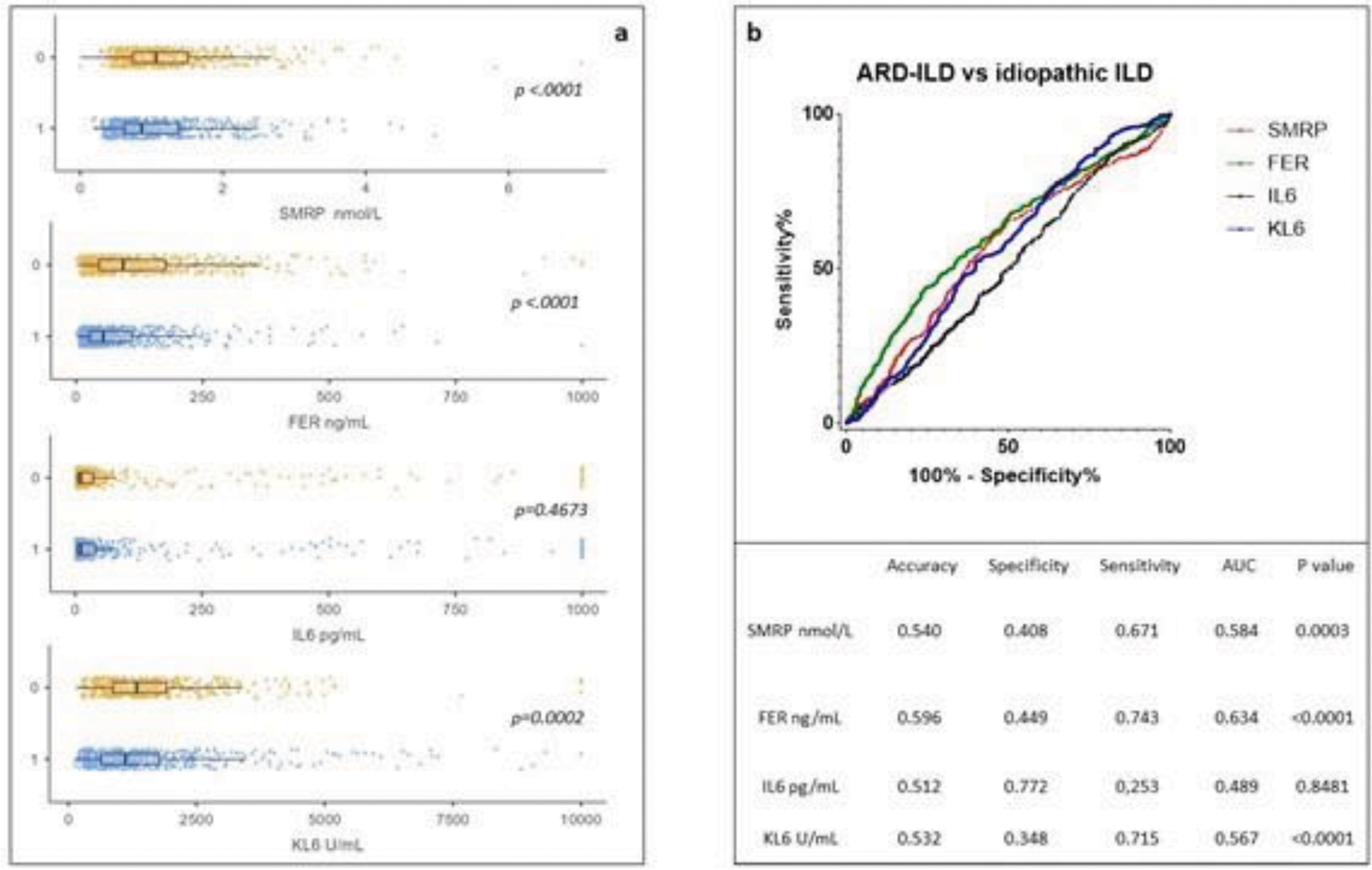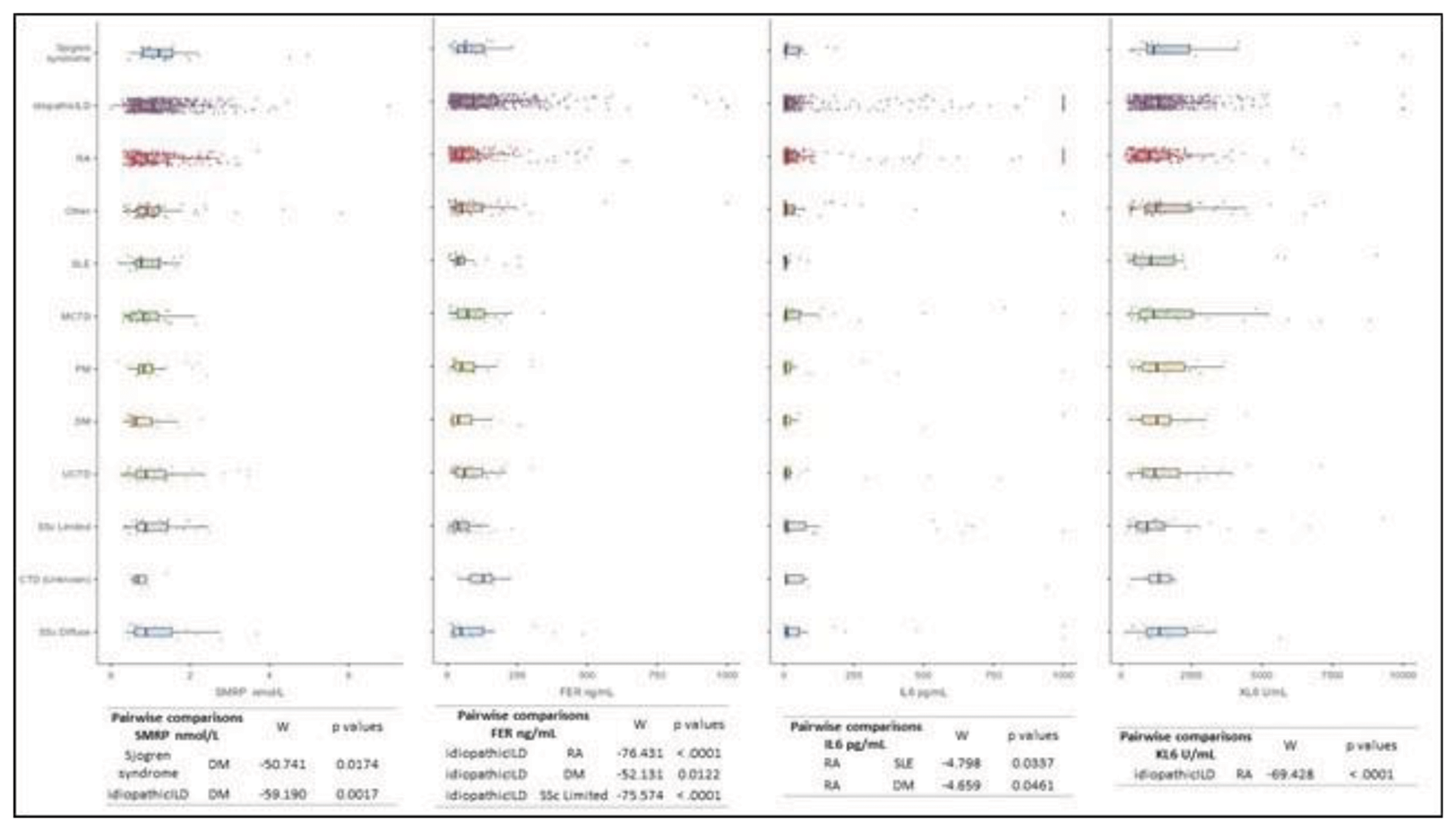

Background: Interstitial lung disease (ILD) may complicate the course of autoimmune rheumatic disease (ARD) and diagnostic biomarkers are needed. Krebs von den Lungen-6 (KL-6), ferritin (FER) and interleukin 6 (IL-6) have been involved in the ILD development.
Objectives: Our study aimed to compare KL-6, FER, IL-6 and soluble mesothelin-related peptide (SMRP) concentrations in a cohort of primary and secondary-ILD.
Methods: 3169 patients were enrolled in the “UK Biomarkers in Interstitial Lung Disease (UK-BILD) Study”. We selected patients affected by ARD-ILD and idiopathic ILD (usual interstitial pneumonia-idiopathic pulmonary fibrosis and fibrotic non-specific interstitial pneumonia). Serum marker concentrations were measured through chemiluminescent assays (Fujirebio Europe, Ghent, Belgium).
Results: 1013 patients were selected for the study: 520 (51.3%) had idiopathic ILD and 493 (48.7%) ARD-ILD. Idiopathic ILD patients displayed higher KL-6 values than ARD-ILD (p=0.0002). FER and SMRP, though within normal ranges, were significantly higher in idiopathic ILD (p<0.0001). Logistic regression showed good sensitivity (69.4%) and specificity (80.4%) selecting the variables FER and KL-6 concentrations, age and gender-male correlated with a diagnosis of idiopathic ILD. These findings enabled us to build a model with an accuracy of 0.755 for differential diagnosis of idiopathic ILD and ARD-ILD based on the following variables: age, gender-male, FER, SMRP, smoking history, Asian and Afro-Caribbean ethnicity, IL-6 and KL-6. Logistic regression showed that the variables that best correlated with a diagnosis of idiopathic ILD were FER and KL-6 concentrations, age and gender-male.
Conclusion: Our multicentre, retrospective study is the first and largest to evaluate an extended panel of serum biomarkers in patients with different types of ILD, including ARD-ILD. We observed normal serum concentrations of IL-6, FER and SMRP in both groups, whereas KL-6 appeared above normal cut-off in most patients but was significantly higher in the idiopathic ILD group. Our study showed the excellent diagnostic value of KL-6 for detecting ILD, which irrespective of the final diagnosis and extent of disease, is always elevated and is a reliable biomarker of lung fibrosis in various diseases, ranging from idiopathic to autoimmune forms. Ours is the first study to report high serum SMRP concentrations in idiopathic ILD. In this context, combination of serum markers and clinical data, as seen in our cohort, may lead to a further improvement in diagnostic accuracy for ILD.
REFERENCES: NIL.
KL-6, FER, IL-6 and SMRP concentrations in ARD-ILD and idiopathic ILD groups. Comparative analysis of median concentrations of four markers in the two subgroups (1a) and ROC curve (1b) of serum biomarkers of patients with idiopathic ILD and ARD-ILD reporting specificity, sensitivity, area under the curve and diagnostic accuracy.

Comparative analysis of serum markers concentrations in idiopathic interstitial lung disease (ILD) versus ARD-ILD subgroups: rheumatoid arthritis (RA), systemic lupus erythematous (SLE), mixed connective tissue disease (MCTD), polymyositis (PM), dermatomyositis (DM), systemic sclerosis (SSc), undifferentiated connective tissue disease (UCTD), connective tissue disease (CTD).

Acknowledgements: NIL.
Disclosure of Interests: None declared.